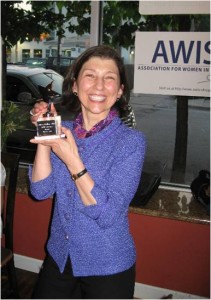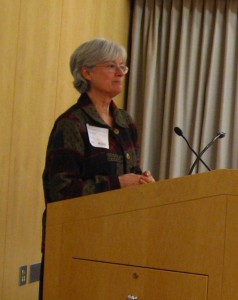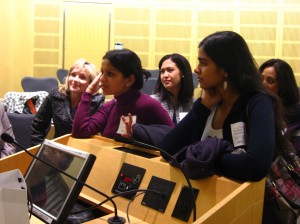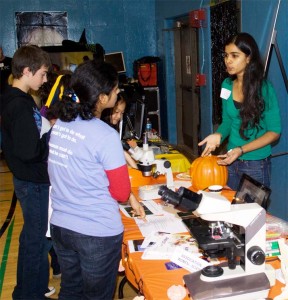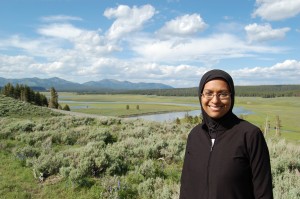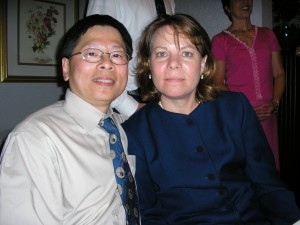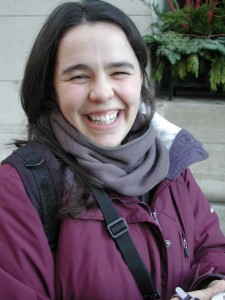October 2010 Scientist of the Month: Jacklyn Naughton – An Advocate for Research
by Marina Viktoria Pazin
 I recall the challenging curriculum and passionate teachers in my science courses at Niles North High School. The introduction to experimentation, the captivating demonstrations, and the triumph I felt with each successful examination all lead me to choose science as a career. I came to admire my honors biology teacher, Jacklyn Naughton, most of all. Though we had not always kept in touch following my graduation from Niles North, we reconnected when I serendipitously took advantage of an opportunity to judge a science fair she was overseeing. I have been judging science fairs and mentoring her pupils in her laboratory ever since. Now, it is an honor for me to feature Jacklyn as a “Scientist of the Month.”
I recall the challenging curriculum and passionate teachers in my science courses at Niles North High School. The introduction to experimentation, the captivating demonstrations, and the triumph I felt with each successful examination all lead me to choose science as a career. I came to admire my honors biology teacher, Jacklyn Naughton, most of all. Though we had not always kept in touch following my graduation from Niles North, we reconnected when I serendipitously took advantage of an opportunity to judge a science fair she was overseeing. I have been judging science fairs and mentoring her pupils in her laboratory ever since. Now, it is an honor for me to feature Jacklyn as a “Scientist of the Month.”
Jacklyn began to teach as a “happy accident.” She began to tutor as a premed student in the 1960s. The gratification she received from teaching and a desire to spend time with her child led her to defer acceptance into medical school and to go into teaching instead. Because she strongly believed in promoting science education among women, who at the time were not expected to be “more than a nurse,” Jacklyn first taught women only, emphasizing research over lectures. When she learned of a biology teaching position available at a co-ed and culturally-diverse Niles North High School in Skokie, she applied. In 1989, her belief in introducing independent research to students landed her the job over 200 candidates.
Jacklyn’s passion for research is reflected in the curriculum she has developed at Niles North over the past twenty years. As soon as she was hired she began to mandate independent research, for the first time in the district’s history, as a component of honors biology courses. Her first mission was accomplished within a year of teaching at Niles North. The following year she developed RIOT (Research and Investigators of Tomorrow) club, to promote STEM-related career development for students. As part of RIOT, students selected research questions and, using the scientific method, conducted experiments that answered these questions to competition. Leading by example, Jacklyn spent many summers conducting research herself, most recently in 2007 at ECCLES Institute for Human Genetics where she met Noble-Prize winning Mario Capecchi. The success of RIOT prompted Jacklyn’s desire to develop a course exclusively for teaching research skills. Jacklyn’s proposals to the board of education for this were initially rebuffed. “For twenty years I was pushing…research class was not a mainstream component of high school education.”
Recently, luck fell on Jacklyn’s side. With the public realizing the need for improved education in the STEM fields, school district 219 received a governmental grant to build STEM labs forming a space for the course Jacklyn had been envisioning. “I remember STEM labs opening at our school in September of 2009, with architects only starting to renovate our space in April of that year.” Finally, in the 2009-2010 school year, Mrs. Naughton unveiled her SIRs (‘STEM Inquiry and Research’) course. Through it, by completing a series of modules, students learn the proper way to develop and test hypotheses in a variety of disciplines, depending on their individual interests. Seeing the opportunity to work in professional labs as an asset, she encouraged students to do so, forming collaborations with prestigious universities Northwestern University, Loyola, and University of Chicago and pharmaceutical companies such as Abbott and Searle in the process.
In just one year the SIRs course has become a success. Its students competed at an International Science and Engineering Fair, with one winning five awards, including an all-paid research internship at Weizmann Institute of Science in Israel. Many more won ‘best in category’ merits at the Illinois Junior Science Academy competition. The number of students interested in SIRs has more than doubled within a year.
Thanks to Jacklyn Naughton, the science experience at Niles North will never be the same.
Nomination and article submitted by AWIS Chicago Staff Writer Marina Pazin.
*Know a scientist you think should be featured in an upcoming “Scientist of the Month” article? Submit your nomination here. Your nominee does not need to be an AWIS member or a woman, but should promote the advancement of women in science, technology, mathematics and engineering.
Want to keep yourself up-to-date on AWIS Chicago activities? Follow AWIS Chicago on Twitter! You can request to be added to our listserve by clicking here, and join the AWIS Chicago group on LinkedIn and Facebook by clicking the icons on the bottom right of this page.

